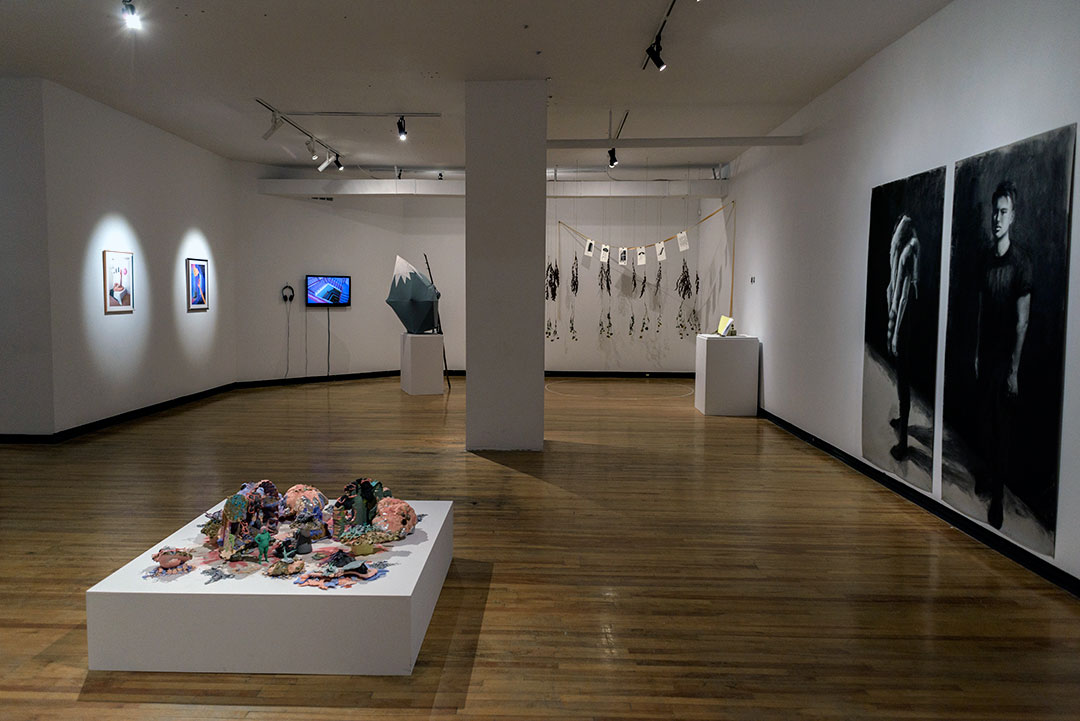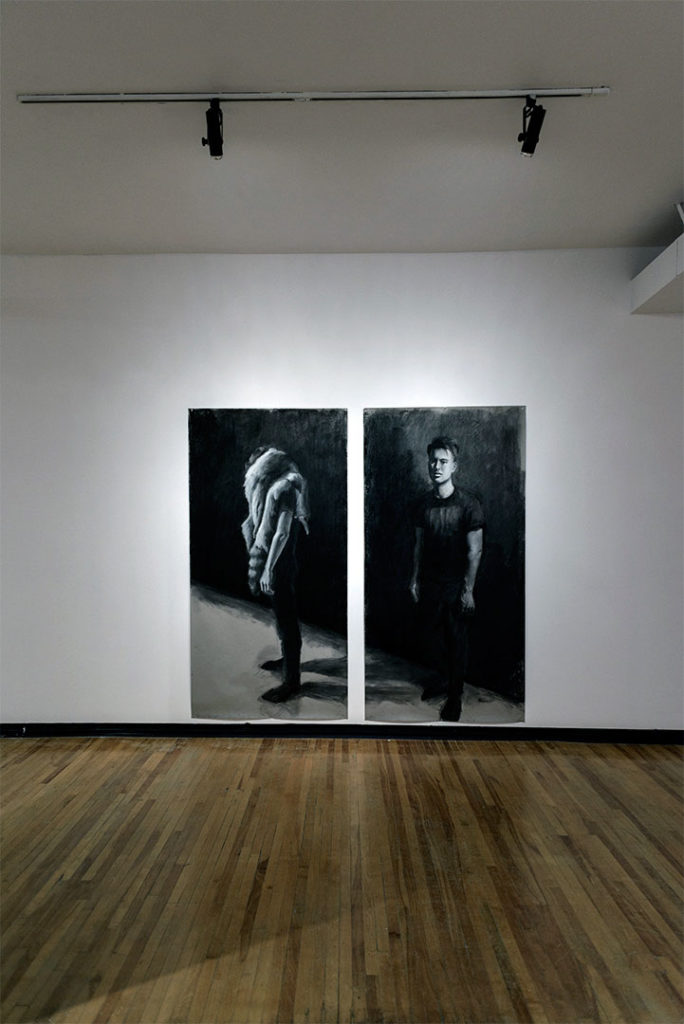On September 26, 1982, artist Nida Home Doherty placed an eight-foot-by-eight-foot raft on the waters of Wascana Lake—a man-made lake in the centre of Regina, bordered by tree-lined walking trails and Saskatchewan’s legislative building—and let it float there for a week. Tethered in place at the lake’s centre, lined with sod, and serving as a stage for performances by local artists, this raft marked the literal and symbolic beginning of Neutral Ground, Regina’s first artist-run centre.
Named, says one source, “as a mark of its neutrality in regards to factions within the arts community,” Neutral Ground was co-founded by Doherty and art history professor Roger Lee. Somewhat unneutrally, following its life as a raft, the centre was run out of Doherty’s home. Then it found other temporary spaces before acquiring permanent gallery space on Scarth Street downtown—one of the most densely populated areas of buildings with heritage value or heritage status in Regina’s downtown. It remained there for some thirty years.
It seems, at first, like a tidy narrative—from lake to house to heritage building, one both like and unlike artist-run centre origin stories in many cities.
But in December, Neutral Ground found itself returning to its humble, transient roots, temporarily operating from an office space on 11th Avenue while they looked for their next permanent gallery space.
The reason? A flood. And with it: a reminder of the precarity of artist-run spaces in this city, a city where a proliferation of physical space does not necessarily translate into a sufficiency of adequate, affordable and equitable spaces for art.
“Canada’s Rectangle,” opened in fall 2017, was to have been a grassroots triumph of sorts—a Neutral Ground exhibition curated by a collective jury rather than by a single director/curator, as was often the case in the past.
(Following Brenda Cleniuk’s departure from Neutral Ground, where she was director from 1991 to 2017, the board stepped in as a working board, putting out an open call to Saskatchewan artists and assembling a jury of local artists and cultural workers—Janine Windolph, Jeff Morton and Edith Skeard, moderated by artist board members Ali King and Terri Fidelak—to curate its 2017 to 2019 exhibitions and programs.)
Featuring work by Jaye Kovach, Zoë Schneider, Cruz Anderson, Jessica Morgun, Cameron Forbes, Amber Phelps-Bondaroff, Nic Wilson and the collective Phomohobes (Jason Cawood and Colby Richardson), “Canada’s Rectangle” provided a snapshot of new works by emerging artists and artist collectives currently making contemporary art in Regina/Treaty 4 Territory.
Video, sculpture, collage, site-specific installation and performance, often engaging themes of place and lands whether real or imagined, were all on deck. Jaye Kovach used plants foraged locally, like prairie sunflowers and dandelion root, in her installation. Zoë Schneider, who is currently completing her MFA in Saskatoon, created Numina’s World for the exhibition—a richly textured and tactile landscape of pastel and earth-toned “land” made with natural (sand, rocks, crystals) and synthetic (plaster, Styrofoam, modelling clay) materials on which an alien-like avatar of the artist stands, hands on hips, taking the world in.
Emerging Cree artist Cruz Anderson’s work Pikwaciyiniw / Sauvage is a diptych of life-size self-portraits made with chalk and charcoal on paper. The work can be seen as a thoughtful reflection on questions of identity and becoming, and on tensions between traditional and contemporary Indigenous identities. In this way, it can also be seen, to take a note from Regina-based Métis artist and professor David Garneau’s “Migration as Territory: Performing Domain with a Non-colonial Aesthetic Attitude,” as an act of aesthetic creation that exceeds colonizing political categories—as a mode of experimenting that resists the Indigenous artist being cast as “always and only a subject of colonization.”
As Garneau puts it in “Migration as Territory”: “Non-colonial, Indigenous aesthetic attitude engages art not only for its political meanings, but also for how it moves us beyond that preoccupation.” With the simultaneity of Cruz’s two self-portraits displayed side by side, and the trace of the artist’s hand through the physical practice of drawing, there is an affect that exceeds the terms that might attempt to generalize or reduce Indigenous practices to being always-already about colonialism. Having worked collaboratively in the past, both with his mother, the prolific Cree visual artist Judy Anderson, and with other emerging artists (like current Neutral Ground staffer Simon Fuh), Cruz Anderson’s solo work held space for reflection in “Canada’s Rectangle.”
But then, the flooding. Neutral Ground had to close the exhibition a week early—with Anderson’s Pikwaciyiniw / Sauvage suffering damage.
There is a sad irony in how these artworks, created by emerging artists who are institutionally more vulnerable than more established artists, were addressing issues of land, place and displacement and were, in the end, displaced or—at worst—destroyed.
Neutral Ground is not the only artist-run centre in Regina to experience displacement, or the need to deal with temporary sites and venues.
Sâkêwêwak and Commonweal Community Arts are, along with Neutral Ground, the three Regina-based members of PARCA, the Plains Artist-Run Centres Association. All three are currently operating out of offices, staging satellite events, projects and festivals without permanent gallery space.
Sâkêwêwak—a Plains Cree word meaning “they are emerging” or “they are coming into view”—was incorporated in 1996 after organizing as an Aboriginal artist community in the Regina/Treaty 4 Territory region since 1991, with founding members including Robin Brass, Reona Brass, Sherry Farrell Racette, Edward Poitras and Âhasiw Maskêgon-Iskêw.
Sâkêwêwak recently launched its refreshed Indigenous-centered mandate as “Regina’s Hub for Contemporary Indigenous Art Production, Presentation, and Education,” and just last month it produced the Sâkêwêwak Annual Storytellers Festival—including artist talks, readings and workshops by Leah Dorion, Sherry Farrell Racette and others at venues including the mâmawéyatitân centre and the University of Regina.
Common Weal Community Arts, founded in 1992, is a provincial arts organization that “collaboratively engages professional artists with communities to promote social change and cultural identity through creative expression.” With the majority of its permanent staff operating out of an office on Smith Street in Regina, Common Weal organizes projects in different areas of the province—including the 2017 exhibition “Axenet’i Tth’al,” a collaboration with Saskatoon’s Wanuskewin Galleries and elders and youth in the community of Patuanak, and Regina photographer Michael Bell’s recent project “A Rightful Place,” which documented newcomers in various parts of Saskatchewan.
There are other artist collectives in Regina that are actively part of the network of artist-run culture, such as Articulate Ink Press, an artist-run printmaking centre founded in 2010 by Michelle Brownridge, Amber Dalton, Karli Jessup and Caitlin Mullan. Articulate Ink is a not-for-profit with a membership structure and mentorship opportunities for its members, and it bears resemblance to classic artist-run structures; they have had studio and exhibition space in different sites around the city, with its studio currently being on the second floor of the mixed-use Creative City Centre space on Hamilton Street.
It’s also worth noting that Queer City Cinema, founded in Regina in 1996 by artist, curator and designer Gary Varro as a biennial film and video festival—and expanded more recently into performance with Performatorium—is another local arts organization that by its very structure counts on short-term, rather than long-term, access to space. Queer City Cinema’s lecture by John Waters last year, for instance, took place at Westminster United Church, while a performance by Shawna Dempsey and Lorri Millan was slated for the Artesian.
Recently, Neutral Ground announced that it has found a new permanent gallery space, and will be moving there in April. It’s happy news, but many wider art-space problems in this region still remain to be resolved.
In the prairie city of Regina, as in many other cities, availability of physical space does not equate to an availability of adequate and affordable spaces for art. Flooding of Scarth Screet Mall aside, taxes were hiked up after Mayor Fougere’s leadership went forward in building a new stadium for the Roughriders, a decision which is costing the city’s taxpayers—and now, artist-run centres too. And Heritage Regina has been raising the alarm about “demolition by neglect”—cases where local heritage-building owners keep buildings empty until they are dangerous enough to tear down and more easily redevelop.
The cynical (and perhaps most accurate) read of some of the city’s changes to downtown Regina over the past decade—which include demolishing the Plains Hotel in 2011 and supplanting the trees and soil in Victoria Park with abrasive concrete “public art” the same year—is that they stem from deeply rooted civic-governmental racism toward the city’s Indigenous communities. Amid this structural racism remains the truth that contemporary Indigenous artists living and practicing in Treaty 4 territory and surrounding areas continue to make much of the most interesting art in the region.
And close-knitness in this place does not come without its issues. Anecdotally, I was told by members of the community that one criticism that has been voiced of “Canada’s Rectangle” and the jury-based curatorial structure slated for Neutral Ground’s next few years is around the problem of curators “curating their friends”—something that is perhaps unavoidable in any smaller community.
This latter point was an interesting question to reflect upon as I made my way through Jeanne Randolph’s “My Claustrophobic Happiness” at the MacKenzie Art Gallery in Regina this winter. This exhibition features both old and new work by Randolph, who coined the term “ficto-criticism” to describe a practice of art writing that emerged from her experience living and working in the 1980s Queen West scene in Toronto—itself a small scene within a larger city. In a sense, this is Randolph’s playful solution to the problems that smaller art communities present to criticism and criticality: a practice that incorporates fictionalization and autobiographical positionings, anecdotes and disclosures into art criticism and art writing.
What community action, art-making, criticism and writing will keep artist-run culture afloat in Regina and Treaty 4 territory in the decades to come? All the initiatives listed here are rafts of a sort—rafts that I hope will persist.
Lauren Fournier is a writer, curator, artist and scholar of experimental feminist practices.
 Installation view of “Canada’s Rectangle” at Neutral Ground in Regina in fall 2017. Clockwise from left: work by Phomohobes, Amber Phelps-Bondaroff, Jaye Kovach, Cruz Anderson and Zoë Schneider. Photo: Copyright Neutral Ground Artist-Run Centre, 2017.
Installation view of “Canada’s Rectangle” at Neutral Ground in Regina in fall 2017. Clockwise from left: work by Phomohobes, Amber Phelps-Bondaroff, Jaye Kovach, Cruz Anderson and Zoë Schneider. Photo: Copyright Neutral Ground Artist-Run Centre, 2017.
This story was corrected on March 8, 2018. In the original, Terri Fidelak’s last name had been misstated as Fidelakto.

 Cruz Anderson’s Pikwaciyiniw/Sauvage as installed in “Canada's Rectangle” at Neutral Ground’s old Scarth Street space in fall 2017. Photo: Courtesy Neutral Ground.
Cruz Anderson’s Pikwaciyiniw/Sauvage as installed in “Canada's Rectangle” at Neutral Ground’s old Scarth Street space in fall 2017. Photo: Courtesy Neutral Ground.







